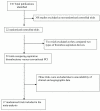Safety and efficacy of thrombectomy in patients undergoing primary percutaneous coronary intervention for acute ST elevation MI: a meta-analysis of randomized controlled trials
- PMID: 20187958
- PMCID: PMC2838805
- DOI: 10.1186/1471-2261-10-10
Safety and efficacy of thrombectomy in patients undergoing primary percutaneous coronary intervention for acute ST elevation MI: a meta-analysis of randomized controlled trials
Abstract
Background: Clinical trials comparing thrombectomy devices with conventional percutaneous coronary interventions (PCI) in patients with acute ST elevation myocardial infarction (STEMI) have produced conflicting results. The objective of our study was to systematically evaluate currently available data comparing thrombectomy followed by PCI with conventional PCI alone in patients with acute STEMI.
Methods: Seventeen randomized trials (n = 3,909 patients) of thrombectomy versus PCI were included in this meta-analysis. We calculated the summary odds ratios for mortality, stroke, post procedural myocardial blush grade (MBG), thrombolysis in myocardial infarction (TIMI) grade flow, and post procedural ST segment resolution (STR) using random-effects and fixed-effects models.
Results: There was no difference in risk of 30-day mortality (44/1914 vs. 50/1907, OR 0.84, 95% CI 0.54-1.29, P = 0.42) among patients randomized to thrombectomy, compared with conventional PCI. Thrombectomy was associated with a significantly greater likelihood of TIMI 3 flow (1616/1826 vs. 1533/1806, OR 1.41, P = 0.007), MBG 3 (730/1526 vs. 486/1513, OR 2.42, P < 0.001), STR (923/1500 vs. 715/1494, OR 2.30, P < 0.001), and with a higher risk of stroke (14/1403 vs. 3/1413, OR 2.88, 95% CI 1.06-7.85, P = 0.04). Outcomes differed significantly between different device classes with a trend towards lower mortality with manual aspiration thrombectomy (MAT) (21/949 vs.36/953, OR 0.59, 95% CI 0.35-1.01, P = 0.05), whereas mechanical devices showed a trend towards higher mortality (20/416 vs.10/418, OR 2.07, 95% CI 0.95-4.48, P = 0.07).
Conclusions: Thrombectomy devices appear to improve markers of myocardial perfusion in patients undergoing primary PCI, with no difference in overall 30-day mortality but an increased likelihood of stroke. The clinical benefits of thrombectomy appear to be influenced by the device type with a trend towards survival benefit with MAT and worsening outcome with mechanical devices.
Figures









Similar articles
-
Adjunctive manual thrombectomy improves myocardial perfusion and mortality in patients undergoing primary percutaneous coronary intervention for ST-elevation myocardial infarction: a meta-analysis of randomized trials.Eur Heart J. 2008 Dec;29(24):3002-10. doi: 10.1093/eurheartj/ehn389. Epub 2008 Sep 5. Eur Heart J. 2008. PMID: 18775918 Review.
-
Role of aspiration and mechanical thrombectomy in patients with acute myocardial infarction undergoing primary angioplasty: an updated meta-analysis of randomized trials.J Am Coll Cardiol. 2013 Oct 15;62(16):1409-18. doi: 10.1016/j.jacc.2013.04.025. Epub 2013 May 9. J Am Coll Cardiol. 2013. PMID: 23665372
-
Thrombus Aspiration in ST-Segment-Elevation Myocardial Infarction: An Individual Patient Meta-Analysis: Thrombectomy Trialists Collaboration.Circulation. 2017 Jan 10;135(2):143-152. doi: 10.1161/CIRCULATIONAHA.116.025371. Epub 2016 Dec 9. Circulation. 2017. PMID: 27941066
-
Myocardial blush and microvascular reperfusion following manual thrombectomy during percutaneous coronary intervention for ST elevation myocardial infarction: insights from the TOTAL trial.Eur Heart J. 2016 Jun 21;37(24):1891-8. doi: 10.1093/eurheartj/ehw157. Epub 2016 Apr 28. Eur Heart J. 2016. PMID: 27125948 Free PMC article. Clinical Trial.
-
Meta-analysis of randomized controlled trials comparing percutaneous coronary intervention with aspiration thrombectomy Vs. Conventional percutaneous coronary intervention during ST-segment elevation myocardial infarction.Catheter Cardiovasc Interv. 2016 Jun;87(7):1203-10. doi: 10.1002/ccd.26352. Epub 2015 Dec 23. Catheter Cardiovasc Interv. 2016. PMID: 26699698 Review.
Cited by
-
Plasmodium spp. mixed infection leading to severe malaria: a systematic review and meta-analysis.Sci Rep. 2020 Jul 6;10(1):11068. doi: 10.1038/s41598-020-68082-3. Sci Rep. 2020. PMID: 32632180 Free PMC article.
-
Thrombus aspiration in patients with ST elevation myocardial infarction: meta-analysis of 16 randomized trials.Anatol J Cardiol. 2015 Mar;15(3):175-87. doi: 10.5152/akd.2015.6114. Anatol J Cardiol. 2015. PMID: 25880174 Free PMC article.
-
Manual aspiration thrombectomy in acute ST elevation myocardial infarction: New gold standard.World J Cardiol. 2011 Feb 26;3(2):43-7. doi: 10.4330/wjc.v3.i2.43. World J Cardiol. 2011. PMID: 21390195 Free PMC article.
-
Effects of the short-term application of pantoprazole combined with aspirin and clopidogrel in the treatment of acute STEMI.Exp Ther Med. 2016 Nov;12(5):2861-2864. doi: 10.3892/etm.2016.3693. Epub 2016 Sep 9. Exp Ther Med. 2016. PMID: 27882086 Free PMC article.
-
Early Administration of Intracoronary Nitroprusside Compared with Thrombus Aspiration in Myocardial Perfusion for Acute Myocardial Infarction: A 3-Year Clinical Follow-Up Study.Acta Cardiol Sin. 2015 Sep;31(5):373-80. doi: 10.6515/acs20150515a. Acta Cardiol Sin. 2015. PMID: 27122896 Free PMC article.
References
-
- De Luca G, van't Hof AWJ, Ottervanger JP, Hoorntje JCA, Gosselink ATM, Dambrink J-HE, Zijlstra F, de Boer M-J, Suryapranata H. Unsuccessful reperfusion in patients with ST-segment elevation myocardial infarction treated by primary angioplasty. American Heart Journal. 2005;150(3):557–562. doi: 10.1016/j.ahj.2004.10.044. - DOI - PubMed
-
- Gibson CM, Cannon CP, Murphy SA, Ryan KA, Mesley R, Marble SJ, McCabe CH, Werf F Van De, Braunwald E. Relationship of TIMI myocardial perfusion grade to mortality after administration of thrombolytic drugs. Circulation. 2000;101(2):125–130. - PubMed
-
- Burzotta F, Testa L, Giannico F, Biondi-Zoccai GGL, Trani C, Romagnoli E, Mazzari M, Mongiardo R, Siviglia M, Niccoli G. Adjunctive devices in primary or rescue PCI: A meta-analysis of randomized trials. International Journal of Cardiology. 2008;123(3):313–321. doi: 10.1016/j.ijcard.2006.12.018. - DOI - PubMed
Publication types
MeSH terms
LinkOut - more resources
Full Text Sources
Medical
Miscellaneous

